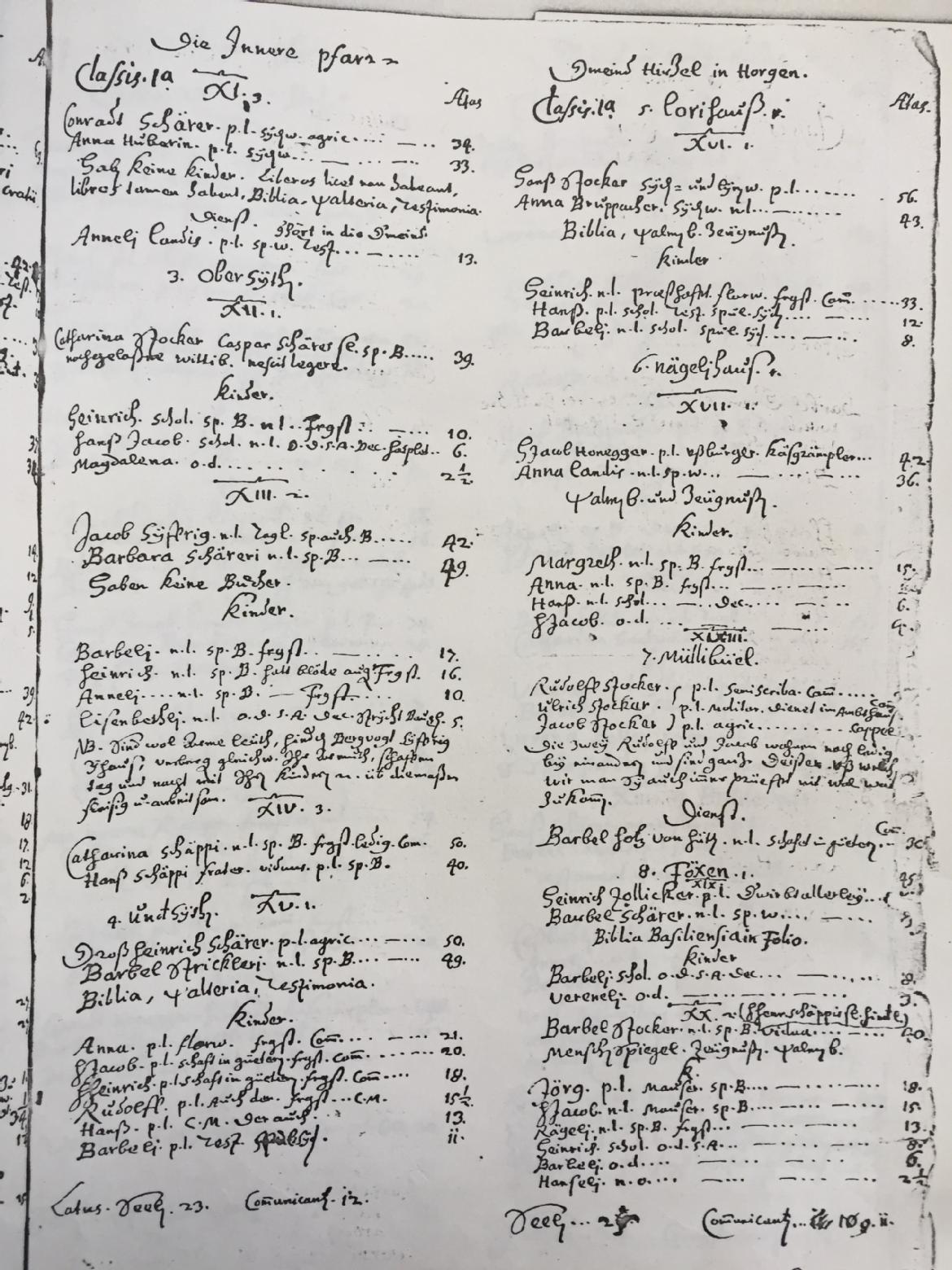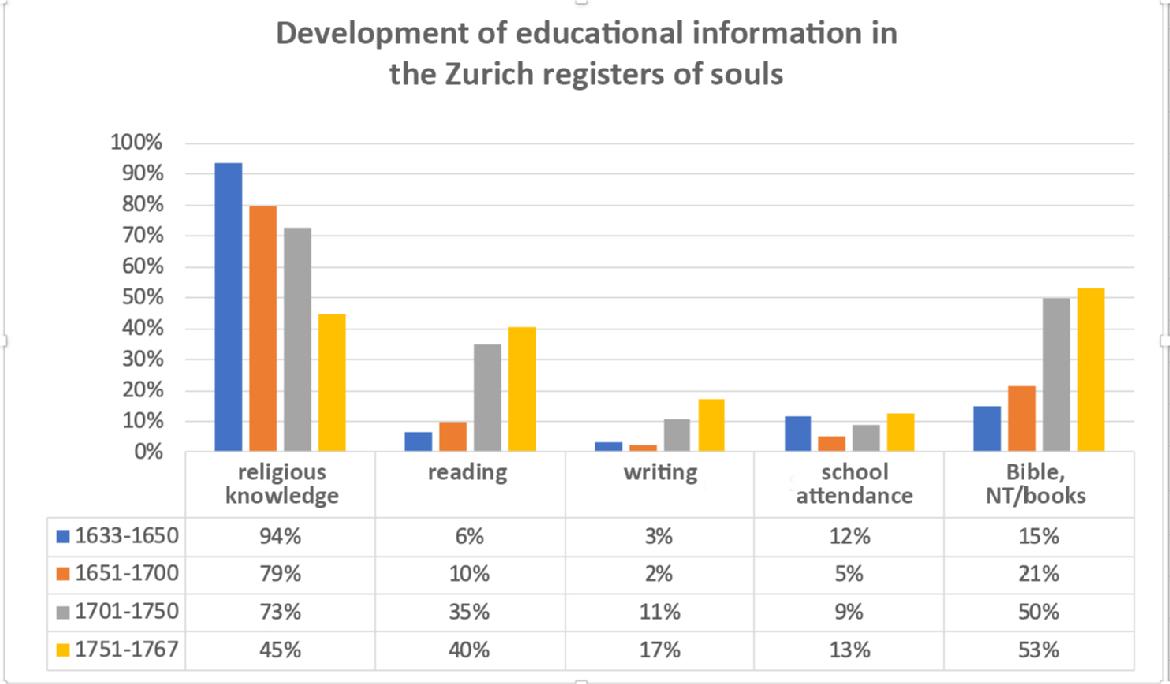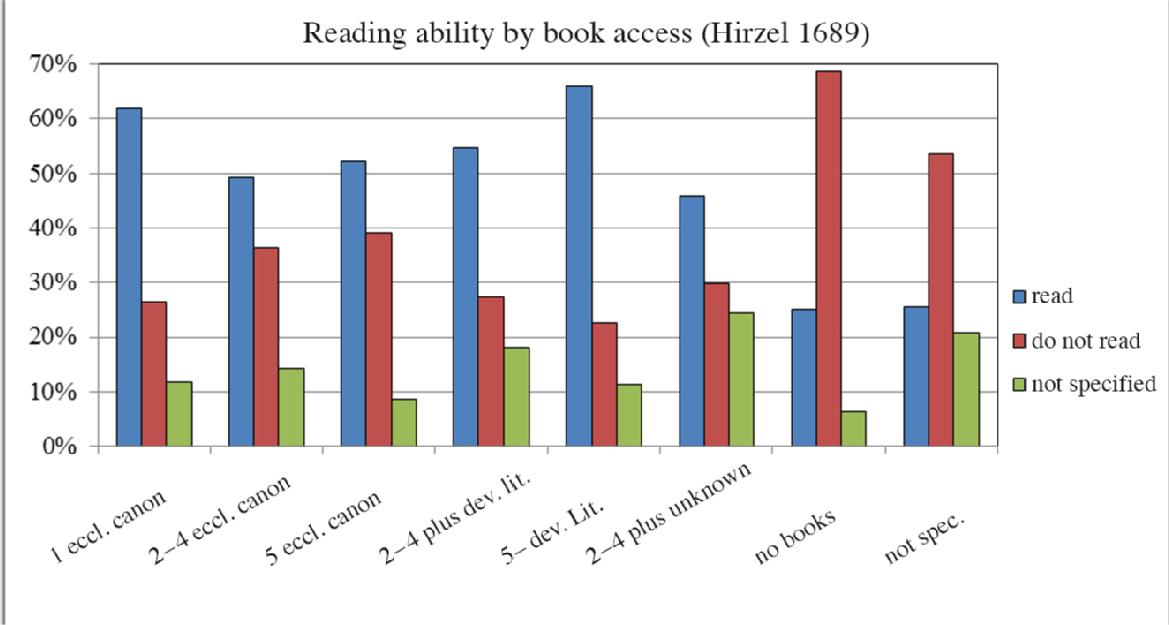A Republic of Readers: 'Registers of souls' as testimonies of literacy in the parishes of Zurich 1630-1770
Michael Egger
The historical study of literacy could be considered as being the ‘climatic history of a culture’, representing fundamental scholarship on the opportunities of women and men to participate in literary discourses of their age. According to the seminal work of Rudolf Schenda (1970), a mere fifteen per cent of the Central European population could read by 1770.[1] This ‘dark age’ of illiteracy was only overcome through the efforts of the Enlightenment or nineteenth-century Liberalism, Schenda argues.
The empirical basis for such claims, however, is weak, complicating any attempt to test the prevailing assumptions. Most scholars have drawn on indirect evidence to make statements about the spread of literacy before 1800: the number of schools, the production / sale of books and inventories of possessions left by individuals.[2] In contrast, research on countries such as France, England, Scotland, Germany and Denmark does employ quantitative analysis, primarily on the basis of people’s ability to sign documents. The results contradict Schenda’s influential hypothesis.[3]
Serial signatures on contracts and marriage certificates are a tricky source for answering the question: ‘Who was able to read and write?’ Signature rates tell us something about the spread of basic writing abilities in a society but it is highly problematic to make wider assumptions about literacy from a mere signature or a cross.[4] For we now know that not only reading and writing, but even the reading of handwriting and print were unconnected in the early modern period and in fact taught as separate skills. Someone who could read a printed text might not necessarily have been able to hold a pen in their hand.
A form of religious census known as Seelenregister, Seelenbeschreibungen, or status animarum (in English they can be referred to as registers of souls), provides us with new evidence on the basic education levels of early modern people. These records of the ‘state of souls’ (rather than bodies) emerged in the course of the seventeenth century as instruments for measuring individual knowledge about matters of faith. Here, copious information on literacy levels was compiled by the pastors. The few local studies produced for Protestant parishes in Germany and Sweden found astonishingly high literacy rates before 1800. No fewer than 74% of parishioners were able to read at e.g. Tuna in Sweden (1691); 72% of men & 39% of women at Bardewisch in Oldenburg (1675); and 91% of men / 89% of women at Kleinheppach in Württemberg (1750-55).[5]
In Zurich, the state archives contain over two thousand sets of such records for the period from 1630 to 1770.[6] Over one hundred of these provide comprehensive and reliable data on reading and – to a lesser extent – writing ability. In total, the literacy rates of a good 50,000 people aged 15 and over, i.e. the age at which they would have completed their basic training, can be calculated. Demonstrably, the reading of printed matter was tested by the priest. Where writing was recorded, however, it is not possible to reconstruct the specific method — the figures could, for example, refer to the mere copying of texts. Furthermore, the Zurich source material offers possibilities for socio-cultural analysis: age and gender are always recorded in the registers, occupations in most cases, more rarely also remarks on school attendance. In particular, the levels of detail on religious book ownership promise fascinating new insights into early modern households.

Fig. 1 The register of souls from Hirzel 1689 – relating to a parish with an extremely high proportion of people working in proto-industry –
is particularly detailed. In addition to names, ages, school attendance (schol), reading (p.l., potest legere) and non-reading (n.l.), prayers and
catechetical knowledge as well as book ownership, the pastor also recorded specific occupational activities. In household XIII.2 halfway
down the left column, for example, we find Jacob, 42, who couldn’t read (n.l.), worked as a day labourer (Tagl.) and also span cotton
(sp. also B), then his wife and children, also non-readers, but all employed at the spinning wheel and without books of their own.
Before presenting some initial results from my current project below, I would first like to say a few words on the character and context of these sources. In fact, even though the genre survives across political and confessional boundaries in early modern Europe (but apparently not for England), it has not yet been studied comprehensively and comparatively. Most family historians and demographers turn to them for information on names and congregation sizes rather than levels of education.
The only monographic work to date was written by Veronika Albrecht-Birkner for the German territory Saxe-Gotha. There, registers of souls were introduced in 1641, in the midst of the Thirty Years' War under Duke Ernst the Pious, alongside a set of educational and religious reforms in the region. Contemporaries interpreted the war as God's punishment, if not a prelude to the Last Judgement. The purpose of this ‘reformation of life’ was to overcome a basic ‘oral’ Christianity in which people only prayed and held ceremonies ‘externally’, quasi performatively. At Saxe-Gotha, the initiative also extended to a large-scale transformation of rural schools and the establishment of both domestic and parish visitations as new forms of monitoring at the local level.[7]
In the Swiss territory of Zurich, the registers of souls were introduced even earlier, in 1633 by the antistes [head of the Church] Johann Jakob Breitinger (1575-1645), i.e. at about the time when the European Confessional War approached the borders of the Confederation. In that year, Swedish troops occupied Constance, which was loyal to the emperor. The threat for Zurich was now twofold: externally, it faced the possibility of a foreign invasion and, internally, a resurgence of Catholicism. With no direct geographical link to key Reformed territories like Basel or Bern, Zurich saw the Counter-Reformation make headway on its own doorstep: growing numbers of followers of the old faith claimed shared use of Reformed churches in neighbouring Thurgau and Rhine Valley.
To make matters worse, conflicts between the adjacent polities of Catholic St Gallen and Zurich almost escalated into a confederate civil war. In addition, numerous Lutheran refugees sought shelter in Zurich parishes and the famous Reformation radicals known as Anabaptists remained conspicuous and active in the Zurich area. Because of their refusal of military service, these nonconformists were persecuted again from 1635.
The reforms of 1633, comprising the first general school regulations, revised / expanded catechisms and domestic visitations, were intended to strengthen confessional identity, the faith of individual subjects, and Zurich’s resilience against perceived 'attacks' from outside. The registers of souls provided a direct evaluation tool for these measures.[8]

Fig. 2 Evolution of coverage in the sources 1633-1770.
In order to better understand the nature of the registers of souls and thus the role of literacy in early modern education, it is worthwhile to analyse what the priests actually covered in their registers. Fig. 2 shows the development of the education-specific data in about 2000 registers of souls surviving for the whole Zurich region between 1633 to 1767. Since no specific or standardised templates existed, what was recorded depended on the discretionary power of the parish pastors.
In general, information on the religious knowledge of children and servants – less often for the master and his wife – in a household was paramount. This related to prayers and familiarity with catechism and psalms. Comparatively rarely, especially in the 1630s, did pastors record reading ability or religious book ownership, and when they did, it was usually only the Bible or the New Testament. Over time, the level of memorised knowledge decreased while the interest of the pastors in literacy and reading increased.
As simplified Christian dogmas to be learnt by heart, but also to be understood in terms of content, catechisms had become the most relevant teaching aid for confessional education in the aftermath of the Reformation. Under Breitinger, the catechisms were revised in 1634, precisely when the registers of souls were introduced. Whole passages of the Bible were added to the existing version together with a range of easier and more difficult questions (small and large catechism). From that moment on, all people were supposed to be able to justify the ‘truths of faith’ with the relevant Bible passage. The ability to read was a prerequisite for learning these so-called ‘testimonies’.
However, it would be inaccurate to see literacy only as a means to facilitate indoctrination. Already for Breitinger, the ability to read was central in itself — thus opening the door for independent learning. For example, the first school regulations in 1634 stipulated that reading, writing and, for an extra fee, calculations should also be taught in rural schools. In practice, he fought battles on multiple fronts. From 1635, Breitinger ordered large quantities of a subsidised, more affordable edition of the Bible to be printed, in which passages perceived as central to the Anabaptist faith were changed in accordance with the Reformed dogma. Additionally, he advised pastors in denominationally mixed areas to stage general Bible readings as a competitive advantage of the Reformed people over the Catholics. Later, the alms office of the Zwinglian Church began annual distributions of the New Testament and prayer books to poor people who could not afford the relatively expensive Bible.
Literacy was promoted by the Church — and it was equally sought after by the population. This demand can be seen in the continual founding of schools, paid for by the heads of households, in towns as well as remote villages. And even in the outlying hamlets of the Zurich countryside people spent considerable sums of money on Bible texts, devotional literature and other religious books. The ability to, at least, read print increased around 1700 at the latest.

Fig. 3 Literacy rates by gender from 26 Zurich rural parishes between 1678 and 1750
based on the most complete registers of souls (with missing data below 7%.)
Figure 3 reveals large variations from parish to parish, most probably due to diverging socio-economic conditions. Yet there are general trends, too: while gender-specific differences are pronounced at the beginning of the survey in the late seventeenth century, the figures became more and more similar. Around 1760, in fact, women had better reading abilities than men in some communities. The latter, on the other hand, retained another educational privilege — in that they were much more likely to be able to write as well as read.
In order to gain a yet deeper understanding, a case study with a low literacy rate but precise data for almost the complete population seems particularly suitable. In 1689, the afore-mentioned parish of Hirzel had Zurich’s highest proportion of inhabitants working in proto-industry, at a time when the spread of spinning wheels and looms in the territory had only just begun. Here, girls and boys were systematically deprived of schooling and women had consistently low reading skills — as is clearly visible in the registers. Figure 4 below illustrates reading ability according to access to books. On the left, we see those parishioners with only one, 2-4 or 5+ officially prescribed ecclesiastical books at home. In the middle, those with 2-4 and 5+ books, of which at least one work belonged to the genre of devotional literature. Here we find the most extensive reading skills. On the right are those with no access to books, where the red stacks are tallest. Book ownership and social status were interconnected, but people in disadvantaged households with at least some books were often still able to read. If we zoom in on groups that were socially disadvantaged for structural reasons but nevertheless owned books, the data suggests that interest in reading could transcend social inequality to a certain extent. For Zurich, at least, such examples reveal a 'republic of readers' instead of what Schenda assesses as a 'people without books'.

Fig. 4 Literacy and book access in the protoindustrial parish of Hirzel in 1689.
Select bibliography
Primary sources
Zurich, State Archive (StA ZH):
- E II 700: Special catalogue of the 'Bevölkerungsverzeichnisse' (registers of souls)
- E II 32, E I 30.12, E I 30.17, E II 114, BVII 21. 95, E II 13b, E I 21.3/4, B VII 21.98, B VII 21.95, E I 30.91, B VII21.95, E I 30.102, E II 385a: diverse bundles of further registers of souls.
- E III: ’Zivilstandbücher der Landgemeinden’ (further registers of souls as well as registers of confirmations and family registers with entries on literacy).
Secondary works
Albrecht-Birkner, V., ‘«Reformation des Lebens» und «Pietismus» – ein historiografischer Problemaufriss’, in PuN 41 (2015), 126-153
Ehmer, H., ‘Ländliches Schulwesen in Südwestdeutschland während der frühen Neuzeit’, in U. Andermann and K. Andermann (eds), Regionale Aspekte des Frühen Schulwesens (Tübingen, 2000), 75-106
Hinrichs, E., ‘Zur Erforschung der Alphabetisierung in Nordwestdeutschland in der Frühen Neuzeit’, in: A. Conrad, A. Herzig and F. Kopitsch (eds), Das Volk im Visier der Aufklärung (Hamburg, 1998), 35-56
Houston, R.A., Literacy in Early Modern Europe: Culture and Education 1500-1800 (Harlow 2002)
Johansson, E., ‘The History of Literacy in Sweden’, in H. J. Graff, H. J. (ed), Literacy and Social Development in the West (Cambridge, 1981), 151-182
Norden, W., ‘Die Alphabetisierung in der oldenburgischen Küstenmarsch’, in: E. Hinrichs and W. Norden (eds), Regionalgeschichte – Probleme und Beispiele (Hildesheim, 1980), 103-164
Hinrichs, E., ‘Lesen, Schulbesuch und Kirchenzucht im 18. Jahrhundert: Eine Fallstudie zum Prozess der Alphabetisierung in Norddeutschland’, in Mentalitäten und Lebensverhältnisse, FS Rudolf Vierhaus (Göttingen, 1982), 15-33
Schenda, R., Volk ohne Buch: Studien zur Sozialgeschichte der populären Lesestoffe 1770–1910 (Frankfurt a.M., 1970)
Schmidt, H. R., ‘Neue Ergebnisse der Alphabetisierungsforschung für die Schweiz und Südwestdeutschland um 1800’, in D. Tröhler, A. Messerli, Osterwalder, F. et al. (eds), Volksschule um 1800, Studien im Umfeld der Helvetischen Stapfer-Enquête 1799 (Bad Heilbrunn, 2014), 149-172
" , Albrecht-Birkner, Veronika; Egger, Michael; Ehrenpreis, Stefan; and Scheurer, Janine (eds), «Seelenbeschreibungen»: Eine frühneuzeitliche Quellengattung und ihr konfessions- und bildungegeschichtlicher Kontext (Berlin / Boston: De Gruyter / Oldenbourg, 2022) [open Access!]
Schofield, R.S., ‘Dimensions of Illiteracy 1750-1850’, in Explorations in Economic History 10 (1973), 437-454
Stone, L., ‘Literacy and Education in England 1640-1900’, in Past and Present 42 (1969), 69-139
Von Wartburg-Ambühl, M.-L., Alphabetisierung und Lektüre: Untersuchung am Beispiel einer ländlichen Region im 17. und 18. Jahrhundert (Bern, 1981)
Biographical note

Michael Egger is a historian from Bern. He was a visiting fellow at the Warwick Network for Parish Research in autumn 2021 and participated in its panel ‘Parish Cultures in the Holy Roman Empire’ at the German History Society annual conference (Roehampton University, 3 September 2021).
His PhD project on early modern literacy and the registers of souls, co-supervised from Bern and Siegen, is scheduled for completion by the end of 2022. The findings are due to appear in the bilingual series ‘Confession and Literacy in the Pre Modern Era / Konfession und Literalität in der Vormoderne’ published by De Gruyter and edited by Prof. Heinrich R. Schmidt, Prof. Veronika Albrecht-Birkner, Prof. Stefan Ehrenpreis and Michael Egger. The first volume on the educational and literacy data recorded in registers of souls surviving in different European countries is scheduled to appear in September 2022.
Any comments, follow-on research or further advice on this project would be most welcome!
Endnotes
[1] Schenda 1970, 441f.
[2] Houston 2002, 125–139.
[3] See the report on current research by Schmidt 2014. Rates for England and Wales by Stone 1969; Schofield 1973.
[4]Hinrichs 1998, 38f.
[5] Johansson 1981; Norden 1980; Hinrichs 1982; Albrecht-Birkner 2002; Ehmer 2000; von Wartburg-Ambühl 1981; Schmidt 2014.
[6] STAZH E II 700.
[7] Albrecht-Birkner, 2002; In an anthology scheduled to appear in autumn 2022, which will launch the new De Gruyter book series ‘Confession and Literacy in the Pre Modern Era’ (co-edited by Veronika Albrecht-Birkner, Heinrich R. Schmidt, Stefan Ehrenpreis and myself), the registers of souls will be surveyed and examined for their value for educational research for Europe as a whole.
[8] Egger 2022.
